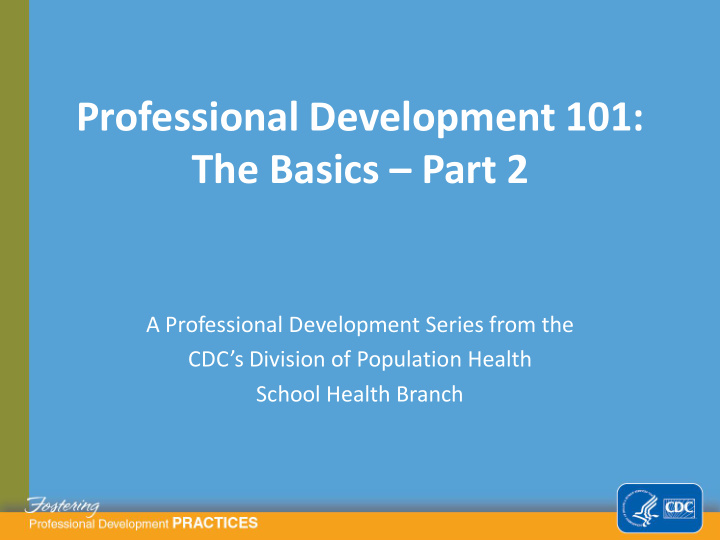



Professional Development 101: The Basics – Part 2 A Professional Development Series from the CDC’s Division of Population Health School Health Branch
Section One: INTRODUCTION
Welcome Bridget Borgogna Melissa Fahrenbruch Health Education Specialist/Project Officer Team Lead, Program and Professional Development Team
Purpose Professional development practices strengthen education delivery and increase skill-building capacity.
Learning Objectives 1. Describe three professional development practices. 2. Describe characteristics of effective use. 3. Identify strategies to support each professional development practice.
Section Two: PROFESSIONAL DEVELOPMENT PRACTICES
Sustain, Design, Market • Sustain a Professional Development Infrastructure • Design Professional Development Offerings • Market Professional Development Services
Deliver, Follow Up, Evaluate
Section Three: DELIVER PRACTICE
Deliver Professional Development • Execution phase • Opportunity to impact learning and create change • Delivered in a variety of ways
Adult Learning Principles Revisited • Experience is respected and built upon • Safe and supportive learning environment • Opportunities to practice skills and apply new knowledge
Training Versus Facilitation Training Facilitation • Unknowns to knowns • Knowns to unknowns • Pre-established objectives • Work toward outcomes • Specific set of skills or • Open discussion in safe knowledge environment
Distinctions Between Trainers and Facilitators
Characteristics of Effective Delivery
Re-Energize and Engage • Take a break • Change the pace • Move on
Team-Teaching or Co-Facilitating • Clarify roles • Agree on when and how to give feedback • Develop communication signals • Intervene when necessary • Have open communication
Key Strategies 1. Provide an environment conducive to learning. 2. Use qualified professional development providers. 3. Collect evaluation data.
Learning Activity One: REVIEW OF DELIVER PRACTICE
Section Four: FOLLOW-UP PRACTICE
Provide Follow-Up Support • Knowledge and skill levels become strengthened • Planned during design phase • Intentional
Follow-Up Support Plan • Summary • Detailed description of support activities • Action plan • Detailed timeline
Professional Development Follow-Up Support - The Continuum
Hypothetical 14-Month Plan Fourteen Three One year Ten months months One month Two weeks months E-mail Website Action E-mail Phone Letters plan interviews Tools
Key Strategies Groups: 1. Plan for follow-up support in the design phase. 2. Share expectations. 3. Provide support. Technical assistance: 1. Plan for follow-up support in the design phase. 2. Schedule follow-up support. 3. Provide intentional follow-up support.
Learning Activity Two: REVIEW OF FOLLOW-UP PRACTICE
Section Five: EVALUATE PRACTICE
Evaluate Professional Development Practices • Systematically monitoring and evaluating professional development events • Collecting data • Using data to improve future efforts
Data • Uses – For future professional development planning – To make revisions to technical assistance protocols – To report success • Collection methods – Pre- and post-questionnaires – Evaluation forms
Pre- and Post-Questionnaires • Two questionnaires – Pre-questionnaire on a set of items before training – Post-questionnaire on same set of items using same rating scale at end of training • Difference in responses represents effects of training
Retrospective Method • One questionnaire – Assessment of before and after knowledge or skill level – Completed at end of training • Lessens the probability of bias
Guidelines for Design • Use concise instructions • Place the pre-training question first • Format the questionnaire in a way that helps respondents
Evaluation Forms • Quantitative responses – Direct questions • Qualitative responses – Open-ended questions
Guidelines for Design • Clear response options • Standardized response categories and scales • Avoidance of biased words, phrases, and jargon • Response options linked to a single issue
Key Strategies 1. Develop plan. 2. Create evaluation instruments. 3. Collect data.
Learning Activity Three: REVIEW OF EVALUATE PRACTICE
Section Six: CONCLUSION
Summary of Professional Development Practices • Sustain a PD infrastructure • Design PD offerings • Market PD services • Deliver PD offerings • Follow up with support • Evaluate PD processes
Professional Development 201: From Basic to Dynamic • Adult learning principles • Facilitation tips • Webinar development
Real-World Application: PRACTICES TO IMPLEMENT
Conclusion Thank you for your participation in Professional Development 101: The Basics
Evaluation Please let us know what you thought! https://orausurvey.orau.org/n/PD101b.aspx We value your feedback.
Certificate of Completion Download your Certificate of Completion now.
Recommend
More recommend